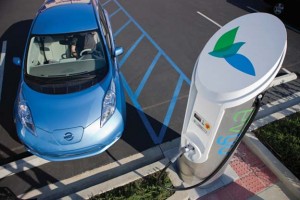
An optimstic scenario foresees plug-ins accounting for nearly one in 10 vehicles on US roads by 2035.
There are an estimated 90,000 plug-based vehicles on U.S. roads today and, with sales only slowly beginning to accelerate, few expect to see that climb to 1 million advanced battery vehicles, as the Obama Administration has called for.
Nonetheless, battery car proponents are nothing if not optimistic, and a new white paper produced for Earth Day by the Edison Foundation projects that even under the most conservative scenario there’ll be at least five million plug-in hybrids and pure battery-electric vehicles, or BEVs, on the road by 2035.
In fact, the figure could jump as high as 30 million, the foundation forecast, in the event of a critical battery breakthrough — or other factors that change the cost/benefit equation.
“Opportunities for electrification in the transportation sector are large and advanced batteries are a major driver,” said Lisa Wood, the Edison Foundation’s Executive Director. “Electric transportation makes economic and environmental sense. Approximately 90,000 Americans have said goodbye to the pump and hello to the plug due to battery advancements and a growing selection of car models that has made driving an EV more accessible than ever before. This number will only grow.”
The mid-range scenario, the Foundation suggested, foresees plug-based vehicles making up nearly 10% of the American passenger vehicle fleet – about 25 million out of an estimated 261 million light duty vehicles.
It also estimates that would reduce CO2 emissions in 2035 by 41 million metric tons.
On the other hand, those battery-cars would require another 112 terawatt/hours of electricity, a figure that critics contend the U.S. energy grid will not be able to handle without major upgrades from today.
Skeptics question any forecast that sees a big jump in plug-in vehicles. Demand has so far lagged expectations. Two key products, the Nissan Leaf and the Chevrolet Volt have missed sales targets since their introduction in late 2010. On the other hand, demand has begun to increase in recent months, especially for the Leaf battery-electric vehicle since Nissan introduced a new, lower-priced version.
(Nissan launches new US battery plant, introduces American-made version of Leaf. Click Here.)
Proponents such as Nissan CEO Carlos Ghosn have scaled back some of their more optimistic forecasts, though Ghosn and others see that as more of a temporary delay than a long-term setback.
Improvements in battery range and reductions in cost are generally seen as two of the most significant barriers to entry, though few observers anticipate major breakthroughs in battery technology for at least another decade, predicting more incremental improvements in the near-term
But they also contend that a significant jump in oil prices could also push more American motorists to make the switch by improving the economic equation in favor of battery power.
While the Obama Administration has been a strong proponent of electrification, it has recently expanded its view to include other alternative power sources, such as natural gas, while also reviving interest in hydrogen fuel-cells – which some see as the ultimate zero-emission technology.
Meanwhile, the U.S. could wind up on the sidelines as other markets rapidly accelerate the implementation of battery technology. China, in particular, is expected to ramp up incentives on plug-based vehicles as it copes with endemic air pollution problems crippling cities like Beijing. That could go as far as putting restrictions on the production of conventional, gasoline-powered vehicles, warns a recent report from Deutsche Bank.
(Could China’s car boom go bust? Click Here for that story.)

Good luckj trying to sell 5 million impractical EVs. The toxic waste from the scraping of these vehicles is going to present a significant problem.
Strangely enough, Obama cut funds for hydrogen fuel-cells when he was elected. Electric power transmission line infrastructure in this country cannot handle the number of electric vehicles quoted. You have to upgrade the line capacity and add new power plants.